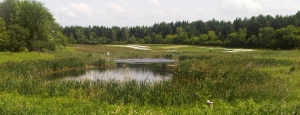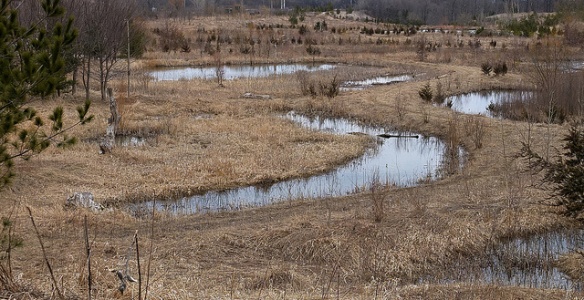Wetlands
Overview[edit]
Constructed wetlands are similar to SWM ponds in function and design, with the most significant difference being that they are designed to incorporate shallow zones for wetland plants. A facility is normally characterized as a wetland if shallow zones (<0.5 m deep) make up more than 70 % of its volume.
Wetlands are an ideal technology for:
- Text A
- Text B
| Type A | Type B | Type C |
|---|---|---|
| Surface water | Minimal Any surface flow can be slowed with check dams |
Ponding is encouraged with check dams |
| Soil | Filter media required | Amendment preferable when possible |
| Underdrain | Common | Uncommon |
| Maintenance | Medium to high | Low |
| Stormwater benefit | High | Moderate |
| Biodiversity benefit | Increased with native planting | Typically lower |
Planning considerations[edit]
Design[edit]
| Element | Design Objective | Criteria |
|---|---|---|
| Drainage Area | Sustaining vegetation, volumetric turnover | 5 Ha (≥10 Ha preferred) |
| Treatment Volume | Provision of appropriate level of protection (Table 3.2) | See Table 3.2 |
| Active Storage | Detention | Suspended solids settling 24 hrs (12 hrs if in conflict with min. orifice size) |
| Forebay | Pre-treatment |
|
| Length-to-Width Ratio | Maximize flow path and minimize short-circuiting potential |
|
| Permanent Pool Depth | Vegetation requirements, rapid settling | The average permanent pool depth should range from 150 mm to 300 mm |
| Active Storage Depth | Storage/flow control, sustaining vegetation | Maximum 1.0 m for storms < 10 year event |
| Side Slopes | Safety |
|
| Inlet | Avoid clogging/freezing |
|
| Outlet | Avoid clogging/freezing |
|
| Maintenance Access | Access for backhoes or dredging equipment |
|
| Buffer | Safety | Minimum 7.5 m above maximum water quality/erosion control water level |
Performance[edit]
Relative to a wet pond, a constructed wetland may offer added pollutant removal benefits due to enhanced biological uptake and the filtration effects of the vegetation.
STEP (under previous name SWAMP) conducted their own research into the performance of stormwater wetlands, the project page and report can be viewed here.
Gallery[edit]
Emergent wetland vegetation supported by stormwater runoff at Kino Environmental Restoration Project. Photo by Matthew Grabau, US Fish and Wildlife Service
Azalea Park, Charlottesville VA - "This side of the park, formerly located along a runoff channel that led into Moore's Creek, has been converted into a wetland which supports a surprising amount of insect and amphibian life." -Credit and Photo: Scott Clark (certhia on Flickr).




